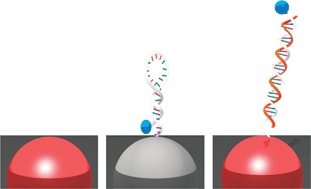Fluorescent molecular nanocrystals anchored in sol–gel thin films: a label-free signalization function for biosensing applications
Abstract
A DNA sensor based on highly fluorescent and photostable molecular

* Corresponding authors
a
Institut Néel, CNRS et Université J. Fourier, BP166, 38042 Grenoble Cedex 9, France
E-mail:
alain.ibanez@grenoble.cnrs.fr
b Genewave, XTEC, Bâtiment 404, Ecole Polytechnique, 91128 Palaiseau Cedex, France
c Interdisciplinary Research Institute, Parc de la Haute Borne, 50 avenue de Halley, BP 70478, 59658 Villeneuve d'Ascq Cedex, France
d Laboratoire de Photophysique et Photochimie Supramoléculaire et Macromoléculaire, CNRS, UMR 8531, ENS Cachan, 94235 Cachan Cedex, France
A DNA sensor based on highly fluorescent and photostable molecular

 Please wait while we load your content...
Something went wrong. Try again?
Please wait while we load your content...
Something went wrong. Try again?
E. Dubuisson, S. Szunerits, M. Bacia, R. Pansu and A. Ibanez, New J. Chem., 2011, 35, 2416 DOI: 10.1039/C1NJ20353C
To request permission to reproduce material from this article, please go to the Copyright Clearance Center request page.
If you are an author contributing to an RSC publication, you do not need to request permission provided correct acknowledgement is given.
If you are the author of this article, you do not need to request permission to reproduce figures and diagrams provided correct acknowledgement is given. If you want to reproduce the whole article in a third-party publication (excluding your thesis/dissertation for which permission is not required) please go to the Copyright Clearance Center request page.
Read more about how to correctly acknowledge RSC content.
 Fetching data from CrossRef.
Fetching data from CrossRef.
This may take some time to load.
Loading related content
